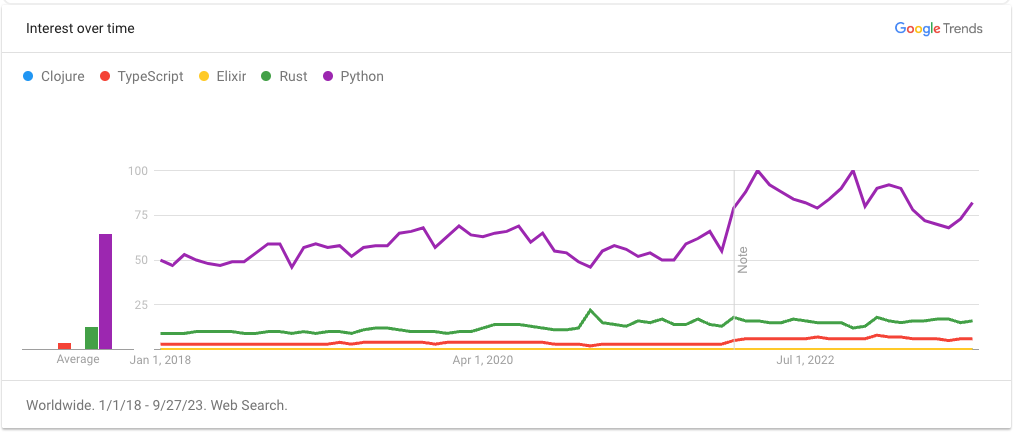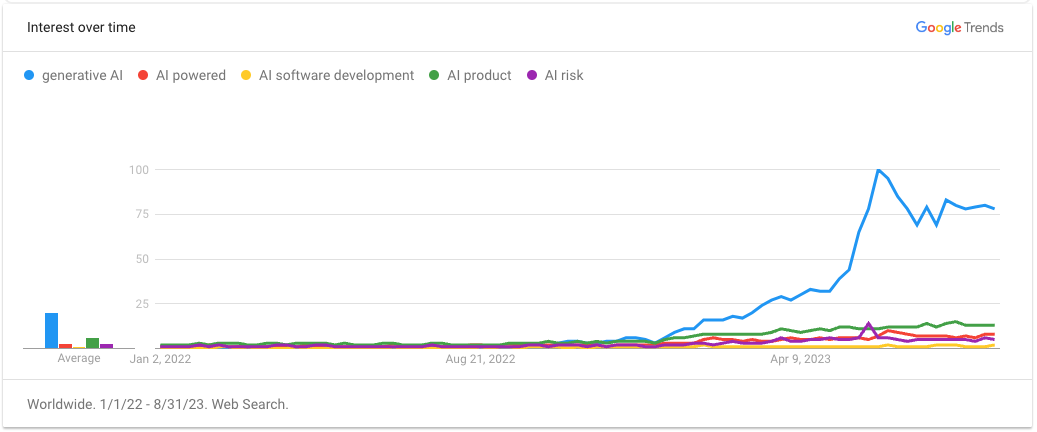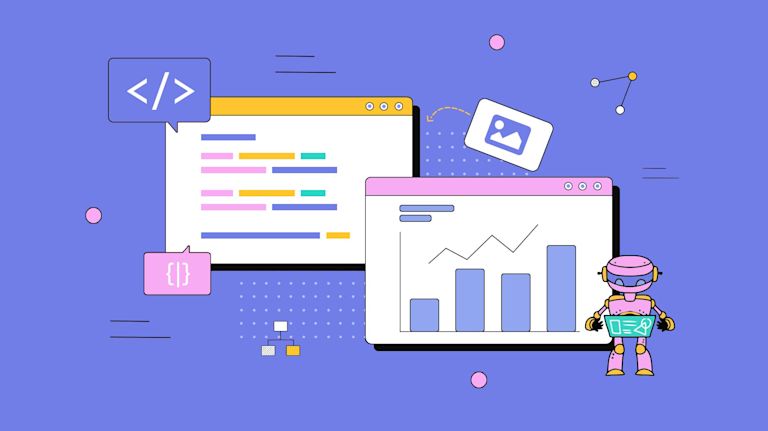Each work year, it’s helpful to take a step back and reflect on the trends in your field. Except, there’s usually not much time for reflecting, and looking into trends. Instead, it’s usually the next pressing deadline which gets consideration. Occasionally, having a resource (one that gives a few, useful insights) can combat a lack of time.
That’s why the Stack Overflow survey is so valuable. It brings with it all the most interesting software development trends together in one place for your perusal.
Adding to the useful information, the following sections contain summaries of some of the most valuable trends for developers working on different projects (not just rich text editors like TinyMCE) comparing results from Stack Overflow surveys of the past few years (2020 to 2023).
You’ll find comparative, software development trends on:
- Developer studies and education
- Technology – what’s feared, dreaded, and admired
- Information on generative Artificial Intelligence (AI)
Software development trends – education
When comparing survey results, one insight that becomes clear is the value of a college or university degree (bachelor’s degree specifically) remains stable across time.
- Results from 2020 indicated 46.2% of software developers attained a Bachelor's degree as part of a career;
- This percentage increasing to 49.34% in 2021,
- There was a small decrease in 2022 at 47.9%,
- And 2023's results showed a shift back to 46.85% similar to 2020.
The trend is less than a 4% variation when comparing results across the past 4 years. It’s a sign your studies are a wise investment. YK Sugi of CS Dojo (1.82M subscribers) wrote in an article for Free Code Camp that there are fundamentals taught at the college level:
“Both Computer Science and Software Engineering teach fundamentals of programming and computer science, so you can choose either one to become a software developer.”
Software development trends: ongoing learning
But what about ongoing learning? In 2021, the survey included software development trends on writing the first line of code. In 2022, the survey expanded with a new section on learning to code.
Learning something new in schools: the role of school-based learning (college and university) for code skills specifically decreased from 62.18% in 2022 down to 50.14% in 2023. Online resource use for learning code skills increased from 70.91% in 2022 to 80.13% 2023.
Hitting the books: Physical media (Books and printed material) use remained relatively stable, with 54.48% in 2022 relying on books for their ongoing study, compared to 51.8% in 2023
You can learn on the job: On the Job training increased: 39.85% in 2022 compared to 46.06% in 2023.
One interpretation of these results is that ongoing learning and training is increasingly moving online and away from a specific location (colleges and universities). Software developers are adding to their knowledge within the workplace. You may find more and more often that ongoing learning in your position or future positions happens as a part of day-to-day work, rather than in a fixed time and place. Experienced developers may be relied on more and more to help new developers with their ongoing learning.
Software development trends: feared, dreaded, and admired
The Stack Overflow survey has consistently gathered scores on what scripting languages are most loved, most feared, and most dreaded. In 2023, the survey questions changed to include questions based around desire and admiration:
- More desired means respondents want to use a technology or language.
- More admired means that respondents used the technology or language in the past year, and want to continue using it.
The idea behind this change of wording is to get a better grasp of which languages are realistically a part of software developers day-to-day work, and which are not. It’s difficult to make a claim that low admiration and desire is the same as dreaded, when the results across time come together, there’s little variation between low desired and admired languages, and dreaded. This lends some credence to the Stack Overflow survey word choice for their sections on Technology use.
|
Top 6 most dreaded languages by year |
||
|
2023 results |
2022 results |
2021 results |
|
COBOL |
COBOL |
COBOL |
|
VBA |
VBA |
VBA |
|
MATLAB |
MATLAB |
MATLAB |
|
Visual Basic (.BET) |
Objective-C |
Objective-C |
|
Groovy |
Groovy |
Groovy |
|
Assembly |
Fortran |
Assembly |
NOTE: The 2023 survey separates VBA and Visual Basic (.NET) into two separate language categories
The amount of dread associated with these six languages is relatively stable across time, with only small variations.
Other language points of interest
Some other languages stand out as noteworthy in regards to the amount of desire or dread surrounding them:
Perls of wisdom: Perl starts as 71.4% dreaded in 2020, drops to 64% dreaded in 2021, stays the same through to 2022 at 65.24% dreaded, and then receives an admiration score of only 34.68% in 2023 (meaning 65% of developers surveyed do not admire Perl).
The top six: Looking closely at the desired and admired scores for the top six languages in 2023:
- Rust is 30.56% desired, and 84.66% admired
- Elixir 4.45% desired, and 73.12% admired
- Clojure 2.20% desired, and 68.51% admired
- Typescript 36.92% desired, and 71.70% admired
- Julia 2.51% desired, and 62.77% admired
- Python 39.81% desired, and 69.52% admired
Rust, TypeScript, and Python: the most well regarded languages – all show a relatively small difference between desired score and the admired score given in 2023, with approximately 30 - 40% variation between desired and admired scores.
Elixir, Julia, Clojure: these languages have much wider differences between the "desired" and "admired" score, with approximately 62 - 72 variation. The conclusion here? If desire and admiration is intended to capture a snapshot of which languages are actually in use in daily software development, The results show that Rust, TypeScript, and Python are trending toward higher use compared to Elixir, Julia, Clojure.
Software development trends: learning Clojure?
Clojure, a functional programming language, is an interesting case. It didn’t appear in the 2020 survey, however in 2021 it surged to being ranked as 81.1% loved.
Software development trends since 2018 show interest in Clojure has remained stable over time:
Stack Overflow survey results across time, however, showed Clojure has appeared in the desired language list. Using the 2023 results, it’s possible to get an idea of what the actual use of Clojure is in day to day software development. There appears to be a small drop in attention and hype around Clojure.

- Clojure is 2.20% desired, meaning few developers among the surveyed group actually want to use the language
- 68.51% admired Clojure, which means that when it’s used in development, Developers find it’s worth using again
Comparing admiration results for 2023 with the 2021 result, where 81.1% of developers ranked Clojure as desirable. In the 2021 Stack Overflow results, developers ranked Clojure as only 1.45% wanted, and compared to the 2023 result of 2.20% desired ranking. Despite the result seen in the 2021 survey (being ranked as 81.1% loved), the software development trend appears to be that Clojure is an admirable language, but is not something to seek training in unless it interests you.
Software development trends – workplace results
In 2020, only 9.5% of developers worked as freelancers, with about the same value in 2021 at 9.65%. In 2022, the number of freelance developers jumps to 15.24% of developers responding to the Stack Overflow survey. This portion remained stable, with a response rate of 15.91% in 2023. This shows a trend toward an increase across the past 3 years for freelance or contractor work.
They’re here all the time: Full time employment remained stable across time. Full time developers represented the following percentage of the survey responses:
- 2021 – 64%
- 2022 – 68%
- 2023 – 69%
Getting into business: For the past 3 years, the majority of software developers surveyed stated they worked at moderately sized businesses of 20 to 99 employees. This has been a consistent response, showing that the size of businesses that employ software developers are consistently likely to have a moderate size, in terms of employees:
|
2023 |
2022 |
2021 |
|
|
20 to 99 employees: |
20.8% |
18.64% |
21.3% |
|
100 to 499 employees |
18.33% |
16.75% |
17.52% |
There’s a consistent trend toward software developers working at moderately sized businesses in the range of 20 to 499 employees.
Coding as a hobby
Coding outside of work is an interesting trend to examine. The 2022 survey found two interesting points:
- Hobbyists who code make up 72.87% of the surveyed population of developers
- 26.11% of Software Developers contribute to open source projects outside of work.
In 2023, these results were lower, with 70.42% reporting code as a hobby, and 24.72% contributing to open source projects. These trends look like expansion and contraction of interests, pointing to ongoing stability over time. Considering the ubiquity of open source software, it's worth keeping an eye on contributions to see if they are reducing moving forward.
Information and software development trends on generative AI
The 2023 stack overflow results on generative AI use showed that AI has had an impact. Of the total developers responding to the survey, 44.17% of professional developers responded that they would make a plan to use AI tools in their development processes this year (2023 to 2024).
This kind of interest is consistent with relevant keyword trends recorded by Google. From the beginning of 2022 to the release of ChatGPT November 2022 and beyond, the focus on topics related to AI have only escalated:

The result is also consistent with results from the 2023 Rich Text Editor survey, which found that AI related use cases for rich text editor software was the third highest use case mentioned (20% of responses).
Predictions for AI
Looking at how software developers predicted how AI would change their day-to-day tasks, survey respondents say the following tasks stood out as likely to be somewhat different with AI included:
- Writing Code – 52.28%
- Debugging and getting help – 46.43%
- Documenting Code – 47.98%
- Learning about a codebase – 43.13%
- Testing code – 43.13%
It’s important, however, to keep expectations reasonable. Writing for Tech Crunch, Devin Coldewey says to consider the validity of how AI is integrated into day-to-day tasks and products:
“Everyone is saying AI is reinventing everything, but it’s one thing to do that at a TED talk; it’s quite another to claim it as an official part of your product. And the FTC wants marketers to know that these [AI] claims may count as “false or unsubstantiated,” something the agency is very experienced with regulating.”
2023 top trends in software development: summary
Here's a summary of the 2023 trends:
- Have confidence in your degree. Fundamentals are of value and still relevant for the Software Development industry, as indicated by the number of developers who’ve studied Computer Science or Software Engineering (among other Bachelor’s degree majors). Study taken in these areas is a wise investment.
- Exploring and learning how to use the most loved languages in the 2021 survey (Rust, TypeScript, Elixir, Julia, Python, and Go) is worthwhile.
- Most software developers work for medium sized businesses, with 20 to 499 employees.
- Pursue learning Clojure only if functional programming is of interest to you.
- Freelancing has increased from 9.5% in 2020 to 15.91% in 2023.
- AI adoption is expected to increase within the next year, and will affect different areas of software development work: Writing Code, Debugging and getting help, Documenting Code, Learning about a codebase, and Testing code.
If you have questions or these development trends have sparked your interest, you can contact us – particularly if you’re finding the job satisfaction interpretation inaccurate.
For more on TinyMCE, check on the TinyMCE documentation, as well as the TinyMCE Roadmap for product development news and updates.
